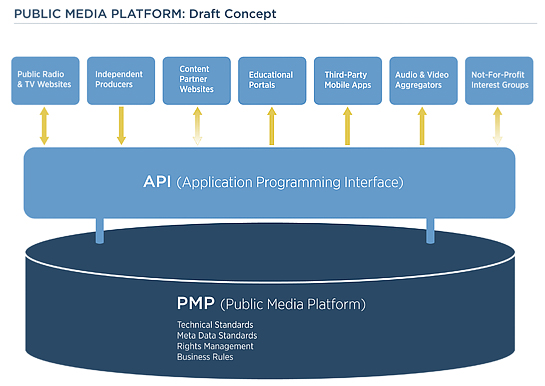Public media is investing in major digital projects
_Public broadcasters — National Public Radio, the Public Broadcasting System and their local affiliates — are playing a significant role in leading media innovation in the 21st century. This is the first of two guest posts about the various projects of “pubmedia” — by which the author refers mainly to public broadcasters and their related Internet efforts. Here’s part two.
_
By Barrett Golding
We in public media have dived into the deep end of nearly every new online pool. For a decade or more, we’ve been masters of our own domain names. Our sites Flash and Flickr with mashed-up multimedia flair. We tweet meet, google group and unconf. We fish for FB friends and Twitter followers. A few of us even find funds for Social Media Strategists, as if that’s a real job.
This post sums up the projects into which public media are making multimillion-dollar, multi-year investments. In the next post, we’ll propose some simpler, grassroots plans to develop smaller-scale, open-source solutions — projects in which independent journalists and developers can participate.
Several large, ambitious, Net-centric projects are currently in development:
PBCore: Public Broadcasting Metadata Dictionary Project
“Metadata is information about information” — tho oft repeated, this is likely among the least informative definitions ever. Specifically, PBCore refers to the tome of extra information a public media Web person must type into the database each time a new media entity (video, audio, etc.) is entered. That way the database can kick out XML with the proper <pbcoreInstantiation>, <subjectAuthorityUsed>, and all kinds of other categorizations awaiting us in our PBCore future. The project was first funded in 2001, vers 1.1 released in 2005, and some of pubmedia’s best & brightest are working hard towards 2.0. PBCore Resources is their user group.
PMP: Public Media Platform
The new Public Media Platform is, right now, more announcement than accomplishment. But it promises big things for where and how public media content gets stored, accessed, found, and shared. The project’s first-year goal is a “proof of concept prototype” (see chart below). NPR’s CEO Vivian Schiller does an admirable job of explaining PMP’s possibilities:

More information about the Public Media Platform can be found at: Public Radio, TV Think ‘New Media,’ by Randy J. Stine
Argo Network
Argo is also an NPR effort (financed with $2 million from the Corporation for Public Broadcasting and $1 million from the John S. and James L. Knight Foundation). A dozen member stations each elect to corral a single topic of utmost import to the geographic areas they serve. So, for instance, Oregon Public Broadcasting is covering the environment, Minnesota Public Radio is focusing on higher education, and KBPS-San Diego is looking at the military. The issues are national, the coverage local. The projects launched this summer, along with the amusing and informative Argo, the Blog.
AAPP: American Archive Pilot Project
The American Archive Pilot Project is another attempt at media asset management. Where the Public Media Project has its head in the cloud-based digital future, this project plans to preserve content from our analog past — all those tapes rotting on station shelves. The goal is to figure out how to restore, digitize, and catalog (using PBCore) all that existing content. In spring 2010, Oregon Public Broadcasting completed a prototype archive. Likely, we’ll hear more soon.
Some reflections
All four of the above projects are well-conceived, led and executed by consummate pros. One or more may rock our world. But all suffer from similar limitations: they’re top-down, closed, exclusive (some proprietary), and expensive.
One other thing they all share: the need to make guesses about the future:
Will producers learn an intricate metadata classification schema? Will this approach make as much sense as we turn towards a Semantic Web? Or will the simpler microformatting of Value Added News prove more useful to most producers (i.e., the hNews format, already adopted by AP, AOL and 200 other sites)?
Does public media need its own platform? Or might time be better spent integrating into existing APIs? For example, YouTube, Vimeo, Flickr, Hulu, and other content providers use oEmbed — its API is now part of the WordPress core.
These are not necessarily either/or answers. But these large-scale projects have made big bets on which way we’ll go. And it’ll be years and millions of dollars before we know if any of their predictions prove true. Even then, any benefits are far more likely to be realized by the bigger networks than by smaller stations and independent producers.
Contrast that with another approach: the bottom-up, grassroots, social inclusiveness of open-source projects — what in tech parlance is more bazaar than cathedral. Imagine some small-scale journocoder community solutions that deliver immediately useful results, cheaply and quickly. Intrigued, aren’t ya? In an upcoming post, we’ll explore ways we can make that happen.
Barrett Golding is Fearless Leader of the Hearing Voices producer collective; and keeper of the PubMedia Commons, where we share code and community. He offered this first of two posts to Hacks/Hackers in an effort to build interest in technology development that supports the mission and goals of public media.



